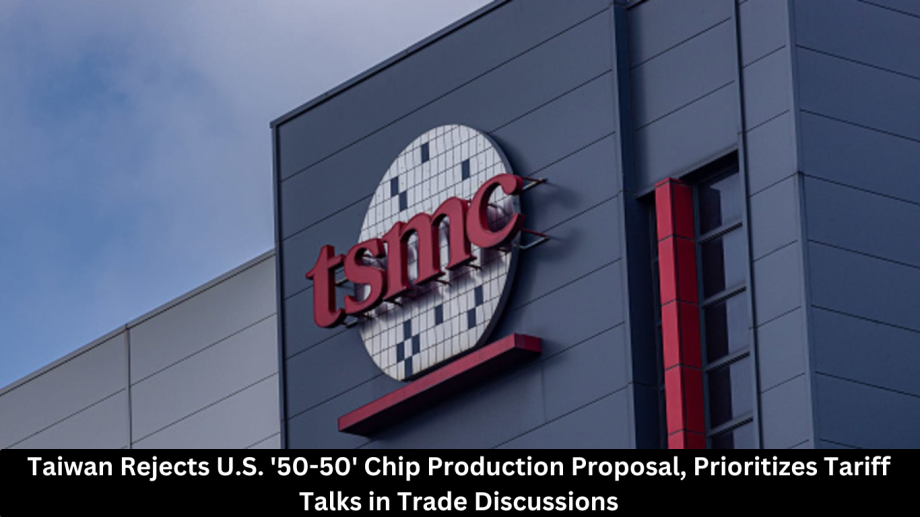In a significant move that underscores the complex dynamics of global semiconductor politics, Taiwan has officially rejected a U.S. proposal for a ’50-50′ chip production arrangement, instead choosing to focus on broader trade discussions centered around tariff reductions and market access.
- What Was the U.S. ’50-50′ Chip Production Proposal?
- Taiwan’s Response: A Clear Rejection
- Why Did Taiwan Reject the Proposal?
- 1. Strategic National Interest
- 2. Industrial Ecosystem Concentration
- 3. High Costs of U.S. Manufacturing
- 4. Security and Sovereignty Concerns
- Focus Shifts to Tariff Talks
- Implications for the U.S.
- TSMC’s Role in the Global Chip Supply Chain
- Global Semiconductor Landscape: What Happens Next?
- 1. Diversification Efforts Continue
- 2. Taiwan Strengthens Regional Partnerships
- 3. China Watches Closely
- 4. Race for Talent and IP
- Expert Opinions
- Dr. Bonnie Glaser, Director, Asia Program, German Marshall Fund:
- Morris Chang, Founder of TSMC:
- Dan Wang, Technology Analyst:
- Frequently Asked Question
- What was the U.S. ’50-50′ chip production proposal to Taiwan?
- Why did Taiwan reject the ’50-50′ chip production proposal?
- What are the main reasons behind Taiwan prioritizing tariff talks instead?
- How does this decision affect U.S.-Taiwan relations?
- What role does TSMC play in this situation?
- Will Taiwan still invest in chip production in the U.S.?
- What are the broader implications for the global chip industry?
- Conclusion
This development comes amid growing geopolitical tensions and an intensifying U.S.-China tech war, with semiconductors—the critical component powering everything from smartphones to military systems—at the center of it all.
More Read: Huawei Leverages AI Technology to Enhance Mate 80 Chip Performance
What Was the U.S. ’50-50′ Chip Production Proposal?
The U.S. has been pushing for shared semiconductor production initiatives as part of its CHIPS and Science Act, passed in 2022, which allocated $52 billion to strengthen domestic semiconductor manufacturing, R&D, and workforce development.
One such initiative proposed a 50-50 production split with Taiwanese firms like TSMC—meaning equal chip manufacturing capacity in both the U.S. and Taiwan.
The goal was to reduce reliance on East Asian production, especially in light of tensions with China, and to ensure the U.S. has secure access to leading-edge chips for critical infrastructure, defense systems, and commercial markets.
However, the proposal also implied that Taiwan should shift a significant portion of its chip manufacturing capacity overseas, which raised red flags in Taipei.
Taiwan’s Response: A Clear Rejection
In an official statement, Taiwan’s Ministry of Economic Affairs (MOEA) said that while the government supports collaboration with like-minded partners such as the U.S., it does not agree to a fixed quota-based production split.
The ministry emphasized that Taiwan’s semiconductor strategy is centered around local innovation, talent cultivation, and supply chain integrity.
“We believe that semiconductor cooperation should be built on mutual benefit and respect for each country’s comparative advantage, rather than rigid production quotas,” said an MOEA spokesperson.
This response was a clear rejection of the U.S. proposal and underscored Taiwan’s desire to retain its leading role in the global semiconductor supply chain.
Why Did Taiwan Reject the Proposal?
Several factors contributed to Taiwan’s decision to reject the ’50-50′ chip production idea:
1. Strategic National Interest
Taiwan’s dominance in chip manufacturing—particularly with TSMC’s cutting-edge 3nm and 2nm process technologies—is a major geopolitical and economic asset.
Relocating a significant portion of production could undermine Taiwan’s leverage in global tech and security diplomacy.
2. Industrial Ecosystem Concentration
Taiwan’s chip industry thrives due to a highly concentrated ecosystem of suppliers, skilled labor, R&D institutions, and government support. Moving production abroad, even partially, risks disrupting this ecosystem and reducing production efficiency.
3. High Costs of U.S. Manufacturing
Manufacturing chips in the U.S. is significantly more expensive than in Taiwan. According to a 2021 Boston Consulting Group report, building and operating a fab in the U.S. costs 20-50% more due to higher labor, utility, and construction costs.
4. Security and Sovereignty Concerns
Relocating cutting-edge chip production abroad could potentially weaken Taiwan’s strategic deterrent.
Some policymakers argue that Taiwan’s semiconductor leadership acts as a form of “silicon shield”, making global powers—particularly the U.S.—invested in Taiwan’s stability.
Focus Shifts to Tariff Talks
Instead of continuing with the chip quota discussion, Taiwan has refocused trade talks with the U.S. on tariffs and broader economic cooperation.
This shift signals Taiwan’s interest in establishing a more equitable and reciprocal trade relationship rather than being pigeonholed into a single industry-based deal.
In recent trade negotiations under the U.S.-Taiwan Initiative on 21st-Century Trade, Taiwan has prioritized:
-
Lowering tariffs on key Taiwanese exports, including machinery, electronics, and agricultural goods.
-
Market access for Taiwanese firms in the U.S.
-
Mutual recognition of standards in areas like digital trade, supply chain resilience, and labor practices.
“Taiwan seeks comprehensive trade cooperation that includes tariffs, investment protections, and technology exchange—not just semiconductor manufacturing,” said a senior Taiwanese trade official.
This pivot reflects Taiwan’s long-standing desire for a bilateral free trade agreement (FTA) with the U.S., which has so far been hindered by political sensitivities surrounding Taiwan’s diplomatic status.
Implications for the U.S.
The rejection is a setback for Washington, which had hoped to secure a larger share of global chip production on home soil. While the U.S. continues to attract investments from TSMC (which is building a $40 billion fab in Arizona), the lack of a 50-50 arrangement means:
-
Taiwan remains the dominant chip manufacturing center, especially for leading-edge nodes.
-
Supply chain vulnerabilities in the event of regional conflict or natural disasters remain unresolved.
-
U.S. tech firms may continue facing chip shortages and high costs until domestic capacity ramps up.
Despite this, the U.S. has reiterated its commitment to working with Taiwan. A spokesperson for the U.S. Trade Representative (USTR) said that Washington respects Taiwan’s position and will continue engaging on areas of mutual interest.
TSMC’s Role in the Global Chip Supply Chain
TSMC is central to this discussion. As the world’s most valuable semiconductor foundry, TSMC manufactures chips for giants like Apple, NVIDIA, AMD, and Qualcomm.
It controls over 50% of the global foundry market, and more than 90% of the most advanced chips (5nm and below).
While TSMC is investing in overseas facilities—including in the U.S., Japan, and Germany—it has made it clear that its core R&D and production operations will remain in Taiwan.
TSMC Chairman Mark Liu has previously warned that replicating Taiwan’s semiconductor ecosystem abroad is “extremely difficult”, and that geopolitical tensions could further complicate cross-border operations.
Global Semiconductor Landscape: What Happens Next?
1. Diversification Efforts Continue
Despite Taiwan’s stance, the U.S., Japan, and the EU will continue efforts to diversify chip manufacturing. Intel, Samsung, and TSMC are all expanding fabs globally, driven by government incentives and the need for geopolitical risk mitigation.
2. Taiwan Strengthens Regional Partnerships
Taiwan is expanding ties with other tech-driven democracies like Japan, South Korea, and the EU to reinforce its position as a trusted supplier and innovation hub.
3. China Watches Closely
China, which has invested billions in its own chip industry, may view this development as a window of opportunity to increase pressure on Taiwan. However, it still lags behind in advanced semiconductor technologies.
4. Race for Talent and IP
As chip firms expand globally, the competition for skilled semiconductor talent intensifies. Taiwan’s deep talent pool remains one of its key advantages.
Expert Opinions
Dr. Bonnie Glaser, Director, Asia Program, German Marshall Fund:
“Taiwan’s rejection reflects its confidence in its chip dominance and a strategic move to avoid being reduced to a mere cog in the U.S. production wheel. This is about preserving sovereignty as much as it is about economics.”
Morris Chang, Founder of TSMC:
“Manufacturing chips in the U.S. is not cost-effective. You cannot simply transplant Taiwan’s entire ecosystem to Arizona or Texas.”
Dan Wang, Technology Analyst:
“This is a wake-up call for the U.S.—you can’t force a key technology partner to follow your lead without respecting their national interests.”
Frequently Asked Question
What was the U.S. ’50-50′ chip production proposal to Taiwan?
The U.S. proposed a “50-50” chip production arrangement with Taiwan, aiming to have Taiwanese semiconductor companies—particularly TSMC—split their manufacturing capacity evenly between the U.S. and Taiwan. This was part of Washington’s broader strategy to reduce reliance on foreign chip production and strengthen domestic semiconductor supply chains.
Why did Taiwan reject the ’50-50′ chip production proposal?
Taiwan rejected the proposal because it raised concerns about national security, economic competitiveness, and the disruption of its semiconductor ecosystem. Officials emphasized that Taiwan prefers to maintain its chip leadership domestically and sees rigid production quotas as unworkable and potentially harmful.
What are the main reasons behind Taiwan prioritizing tariff talks instead?
Taiwan is seeking a more comprehensive trade partnership with the U.S., beyond just semiconductor collaboration. By focusing on tariff reductions, market access, and supply chain agreements, Taiwan aims to improve its overall trade environment and push for a potential bilateral free trade agreement (FTA) in the future.
How does this decision affect U.S.-Taiwan relations?
While the decision may be a short-term setback for U.S. ambitions to localize chip production, it does not fundamentally damage U.S.-Taiwan relations. Both sides remain committed to strategic cooperation, and discussions have shifted to more balanced economic topics like digital trade, tariffs, and investment.
What role does TSMC play in this situation?
TSMC, the world’s most advanced chip foundry, is at the center of this issue. Although it is building fabs in the U.S. (Arizona), TSMC has made it clear that core R&D and cutting-edge production will remain in Taiwan. The company supports international collaboration, but not at the expense of Taiwan’s dominance in the industry.
Will Taiwan still invest in chip production in the U.S.?
Yes. Taiwanese companies like TSMC are still investing in U.S.-based manufacturing facilities, including a major project in Arizona. However, these are considered supplementary operations rather than a shift of core capabilities. Taiwan wants to support U.S. interests without compromising its strategic position.
What are the broader implications for the global chip industry?
The rejection of the proposal highlights the geopolitical complexities of global tech supply chains. It reinforces Taiwan’s central role in chip manufacturing while pushing the U.S. to further develop self-sufficiency. It also signals that future tech cooperation will likely require mutual respect, not unilateral demands.
Conclusion
Taiwan’s decision to reject the U.S. ’50-50′ chip production proposal marks a turning point in global tech diplomacy. It reinforces Taiwan’s desire to retain its semiconductor leadership while expanding trade cooperation on broader and more equitable terms.
While the U.S. continues to strengthen its domestic chip capabilities, Taiwan’s message is clear: it will remain a central, independent pillar of the global semiconductor industry—on its own terms.
As global powers navigate the future of technology, sovereignty, and trade, the Taiwan-U.S. chip dynamic will remain a critical part of the story.








